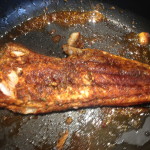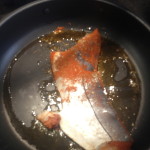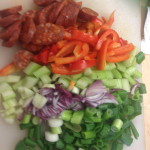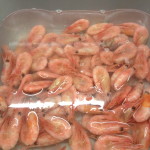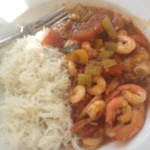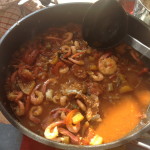The thing about gumbo is that it’s not a recipe but a family of recipes. As quoted in Wikipedia:
Gumbo is a dish that originated in southern Louisiana during the 18th century. It typically consists primarily of a strongly-flavored stock, meat or shellfish, a thickener, and seasoning vegetables, which can include celery, bell peppers and onions (a trio known in Cajun cuisine as the “holy trinity“). Gumbo is often categorized by the type of thickener used: the African vegetable okra, the Choctaw spice filé powder (dried and ground sassafras leaves), or roux, the French base made of flour and fat. The dish likely derived its name from either the Bantu word for okra (ki ngombo) or the Choctaw word for filé (kombo).
Several different varieties exist. In New Orleans, what is known as Creole gumbo generally contains shellfish. Cajun gumbo varies greatly, but often has a dark roux with either shellfish or fowl, but not together. The Creoles of Cane River make a gumbo focused much more on filé. After the base is prepared, vegetables are cooked down, and then meat is added. The dish simmers, with shellfish and some spices added near the end. Gumbo is traditionally served over rice.
The dish combines ingredients and culinary practices of several cultures, including West African, French, Spanish, German, and Choctaw. Gumbo may have been based on traditional West African or native dishes, or may be a derivation of the French dish bouillabaisse. It was first described in 1802, and was listed in various cookbooks in the latter half of the 19th century. The dish gained more widespread popularity in the 1970s, after the United States Senate cafeteria added it to the menu in honor of Louisiana Senator Allen Ellender. The popularity of Louisiana-born chefs such as Justin Wilson and Paul Prudhomme in the 1970s and 1980s spurred further interest in gumbo. The dish is the official cuisine of the state of Louisiana.
In short, so long as it is roughly a spicy stew with fish and meats, you can add pretty much anything you like and still be authentic. For these purposes I looked at a good half dozen recipes before setting forth on my own perilous journey down the River Gumbo.
The first thing I remember from eating it in the States, and indeed in cooking gumboesque dishes in the past, was that it is a dish where you get messy. You use cutlery but you also pick stuff up and keep serviettes to wipe hands and face afterwards!
First element of the messiness is undoubtedly what in the US they call “shrimp” but to us is “prawn”. It would be easy to chuck in a load of shelled prawns, so the best approach is to include some requiring action from the eater. I therefore got a combination of raw crevettes – big tiger prawns – and cooked prawns in the shell. In both cases the heads, legs, part of the shells and veins were removed, leaving a prawn you could pick up by the tail and suck the meat out of. Perfect!
You could use any other seafood, including crabs and fillets of white fish. Here, I used a fillet of haddock, but fried it in “Cajun spices” first. Typically this will be a mixture based on cayenne pepper. The version I created was similar to this version through the inclusion of salt (unkosher sea salt flakes in my case), ground black pepper, smoked paprika, thyme, oregano and cumin. This seemed to work well and is included here.
I chose to use chopped chorizo sausage rather than the more traditional andouille, but either work well here. In fact, the paprika in the chorizo blends well with the Cajun spices.
Most recipes include clam juice, an ingredient doubtlessly available in the deep south but not in British supermarkets. Its absence is compensated for here by the inclusion of wine, chicken stock and fish sauce. This is an excellent product, generally made in Asia and used in a variety of Asian dishes, that adds savoury depth and pungency not only to fish but also meat dishes, much in the same way that Worcester Sauce, made from anchovies, is often included in casseroles and other meaty foods.
Method
Create your Cajun spice mix (see above) and put in a wide flat dish. Take a fillet of white fish and coat well on all sides with the spices (keep the remainder – you will need a good quantity of them.) Put the to one side for a few minutes and cut into chunks.
Part-peel and devein your prawns (see above) and prepare any other seafood you want to add to the dish. Keep raw and cooked separately.
Make a thick roux by heating oil and butter in a big pan or casserole, then stirring in plain flour and the spices to make a paste. Meanwhile, heat a wide frying pan, add olive oil and then the “holy trinity” of chopped onions, celery and peppers – plus spring onions here. Stir and fry, then add two chopped/crushed garlic cloves and chopped slices of chorizo or similar sausage.
Allow to sautée gently then add to the big pan with the roux. Add 1-2 beefsteak tomatoes, peeled and chopped coarsely, a glass of wine and stir well. Allow to come to the boil, then add chicken stock to cover and a good squirt of fish sauce. Also a good slug of your favourite chilli sauce, be it Tabasco or any other (in my case it was the tangy Rocket Fuel sauce.) Bring back to the boil and allow to simmer.
Take the wide frying pan you were using to and put that on a high heat with some olive oil. Cook the fish rapidly on both sides and remove. Do not overcook!
When the gumbo is thick and tasty, add the seafood. Remember to pre-cook the raw seafood, or add it to the gumbo earlier to cook, and to add the cooked prawns at the end to stop them getting tough. Layer the cooked Cajun fillets on top.
Serve immediately with rice. It should have a smoky, spicy flavour but not blow the top of your head off. Enjoy!






